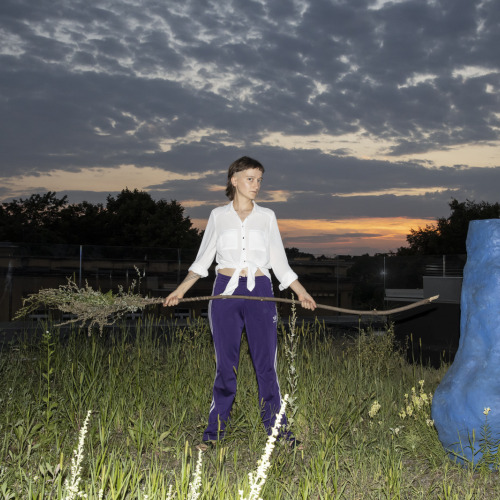
People Like Us & Semiconductor
People Like Us is a dispersed yet solid, small yet
imposing orchestra of one-namely, Vicki Bennett. In short, it could be
said that PLU, who through eleven years of digital collaging have achieved
avant-garde icon status, merely comment on various cultures and explore their
most extreme manifestations. PLU projects make reference to the most absurd
stereotypical aspects of life in different cultures by re-contextualising
sounds and images from the margins of society. Their work uses material from
obscure radio programmes, especially from South-eastern Britain and BBC four,
including babbling and idiotic dialogue; the music recalls polka dances, with a
lot of kitsch and all that a culture is, deep down, usually ashamed of. Take,
for instance, an image of the Alps, filled with happy couples on ski lifts. We
can also observe the stupid faces of a family in front of the TV, industrious
workers, clean farming machinery, idyllic landscapes, friendly secretaries,
devoted housewives and other similar stereotypical, well-known television
icons, which Vicki Bennett-who is also a committed theoretician and a practical
advocate of the "copyleft" or "no-copyright" point of
view-steals from various archives and simultaneously computer-processes them,
adding other humorous interventions, and so constructing her very own special
Christmas tree. Thanks to this simultaneous editing, a surreal world of failed
relationships and miscommunication emerges in which the presented interviewees,
lost stars and found sounds connect in a beautiful loop of references and
repetitions. For example, love song-an old passion of Vicki Bennett-lulls the
audience into a trance of unique monotones. The artist describes herself as
"an heiress of British satire, although it has not had a great
influence" on her. In any case, she is, as she says, a surrealist and an
absurdist, with a real gift for bitter, dry humour, which has filled her work
for many years. The musical part of her performances has become ever more
important to her, and she has been actively recording it on albums with such
bizarre names as Recyclopaedia Britannica, We Edit Life. A Fistful of
Knuckles, Thermos Explorer, Lowest Common Dominator, Lassie House, Another Kind
of Humour, Another Kind of Murder, and so on. Listening to these albums,
one easily recognises quite a bit from her unique audio-visual manner. Vicki
Bennett recently received access to the extremely abundant film archive
established by Rick Prelinger in New York in 1983, which comprises more than
48,000 "ephemeral" educational, industrial and amateur films. The
archive is officially owned by the Library of Congress, but
unofficially…
Semiconductor - Ruth Jarman and Joseph Gerhardt-do
things in the semidarkness of their computer screens that resemble, from a
technical point of view, the work of People Like Us, although the world
they deal with is completely different in both sound and image. In many ways,
this world complements that of Vicki Bennett: virtual cities, digital
earth-quakes, power outages, the consequences of viral pandemic diseases (such
as their work Digital Anthrax) and other catastrophes-chaos in the face
of unimagined human interventions… The artists work, for the most part, with
the state of human consciousness-cellular entities fighting among themselves on
a sub-molecular level. Holes, clefts, vacuums, forming in mentalities long ago
abandoned by both moderation and stability, are not merely superficial here;
Semiconductor peers deep into darkness, where they stumble on both spontaneous
and pre-programmed, both abstract and figurative and, finally, both visual and
auditory phenomena. Jarman and Gerhardt are hardly afraid of the increasing
paranoia in which their work is seen and heard, the possibility that
civilisation might at any moment implode, if not explode-indeed, this is
something that can be secretly expected. These two Brighton immigrants living
in London have thus become a synonym for digital noise and computer anarchy
over the past few years. They construct tabletop, handy or obvious concert-hall
environments in which one can comprehend a larger and more distant image. In
many cases, they use sound to create a simulation of the road between virtual
and actual reality. Their work expands from the activity of the simplest life
forms to imposing architectures and constantly changing landscapes. On the
sound level, Semiconductor combines digital data and analogue signals, creating
the impression of artisanship. They constantly take into consideration and
acknowledge the possibility of chance and computer freezes, and are full of
contradictions, as their music sounds both rustling and violent, minimal and
maximal at the same time. "Noise is undesirable sensory information,"
say Ruth Jarman and Joseph Gerhardt, discussing their live performance in Wire
magazine (June 2003). "In the world of computers, everything is pure,
which means a little bit of noise needs to be added for people to feel
comfortable. The idea of noise is both visual and auditory. A parallel of
emotions can be seen within it: it is not about merging two emotions, it is
about comprehending them as one. It looks like computer anarchy. Computers can
only simulate it."
Miha Zadnikar
People Like Us
Sound, image: Vicki Bennett
Semiconductor
Sound, image: Ruth Jarman
Sound, image: Joseph Gerhardt
Organisation: City of Women
In co-operation with: Slovenska kinoteka - Kino-uho: neogibno 40a+b
With the support of: The British Council


